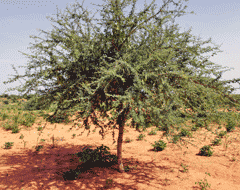
Acacia senegal

Gum arabic is an emulsifier with high solubility in cold aqueous solutions with low viscosity.
Raw gum arabic exudate,
from Simon A. Eugster

Gum arabic (E414, acacia gum) is wound-protective colloid prepared from an exudate from the stems and branches of sub-Saharan (Sahel zone) Acacia senegal and Acacia seyal (Leguminosae) trees and produced naturally as large nodules during a process called gummosis to seal wounds in the bark of the tree. It is a less consistent material than other hydrocolloids. There are recent reviews of this [1759], an earlier one together with other exudate gums [562] and a review of its applications [2651].
Gum arabic is a complex and variable mixture of arabinogalactan
oligosaccharides, polysaccharides, and glycoproteins. They are mainly formed by chains of 3,6-linked β-D-Galactopyranose substituted in position 6 by side chains of 3-linked α-L-arabinofuranose [2368]. There are structural differences dependent on the source with A. senegal having greater branching (78.2% vs. 59.2%) than A. seyal with more D-galactose
relative to L-arabinose, more branched galactopyranoses, shorter arabinosyl side branches, and more rhamnopyranoses in the terminal positions. The gum from Acacia seyal also contains significantly more 4-O-methyl-D-glucuronic
acid but less L-rhamnose and unsubstituted D-glucuronic acid than
that from Acacia senegal [370]. [Back to Top ![]() ]
]
Gum arabic consists of a mixture of lower relative molecular mass (molecular weight) polysaccharide
(M.Wt. ≈ 0.25x106; major component) and higher molecular
weight hydroxyproline-rich glycoprotein (M.Wt. ≈ 2.5x106 minor component) [368] but with wide variability between commercial samples [1526]. Because
it is a mixture and the material varies significantly with its source(s),
the exact molecular structures are still rather uncertain [2368, 3551]. Its glycoprotein
is a high molecular mass hydroxyproline-rich rich arabinogalactan (≈ 2%
protein) containing a repetitive and almost symmetrical 19-residue
consensus motif -ser-hypa-hypa-hypa-thr-leu-ser-hypb-ser-hypb-thr-hyp-thr-hypa-hypa-hypa-gly-pro-his-
[368] with contiguous
hydroxyprolines (a) attached to oligo-α-1,3-L-arabinofurans
and non-contiguous hydroxyprolines (b) attached to galactose residues of oligo-arabinogalactans.
combining a β-1,3-D-galactopyran core with
side chains of β-D-uronic acids, β-D-galactose, α-L-arabinose, and α-L-rhamnose joined to the main chain by 1,6-linkages [368] and single termini of α-L-rhamnopyranose, α-L-arabinofuranose and β-D-uronic acids via 1,2- and 1-4-linkages [A. senegal 1949; A. seyal 1991]. [Back to Top ![]() ]
]
As with many other hydrocolloids, gum arabic is a useful prebiotic promoting beneficial physiological effects [1157, 1467,2367]. As a food additive, it is a useful if rather an expensive hydrocolloid emulsifier, texturizer, and film-former, widely used in the drinks industry to stabilize flavors and essential oils, for example in soft drink concentrates. The simultaneous presence of hydrophilic carbohydrate and hydrophobic protein enables its emulsification and stabilization properties. Emulsification, which is dependent on the amount of arabinogalactan protein present [1526], is particularly enhanced due to molecular flexibility which allows greater surface interaction with the oil droplets. Gum arabic is used in confectionery such as traditional hard (wine) gums, pastilles and as a foam stabilizer in marshmallows. It has also been used to gum the back of postage stamps.
The gum arabic glycoprotein possesses a flexible but compact conformation. It is readily soluble to give relatively low viscosity Newtonian solutions even at high concentrations (20-30 % wt/wt). However, and rather confusingly, molecular aggregation can cause both shear thinning and time-dependent thickening behavior at low shear [369].
Gum tragacanth (Astragalus gummifer, E413)
is a related exudate gum consisting of a mixture of polysaccharides
including an arabinogalactan containing α-L-arabinofuranose
and 1-4-linked β-D-galactopyranose
[367] and an acidic complex
poly-1-4-linked α-D-galacturonate.
It is used as an acid-resistant thickener and emulsifier in sauces,
salad dressings, and confectionery lozenges. Another exudate
gum, gum karaya (Sterculia urens) has similar physical
properties but consists of an α-D-galacturonic
acid/α-L-rhamnose backbone with β-D-galactose
and β-D glucuronic acid side chains.
Another related gum is the main component of mesquite gum (Prosopis) [1720];
an arabinogalactan with a β-1,3-galactopyranose
core and L-arabinose side chains. Gum ghatti is also an emulsifying exudate gum, from the Anogeissus Latifolia tree, containing alternating 4-O and 2-O- substituted α-D-mannopyranose units and 1-6-linked β-D-galactopyranose chains [1526, 1527]. Acacia tortuosa gum is also a highly branched soluble arabinogalactan [2369]. Acacia gum has been compared with Acacia nilotica exudate gum [3031]. [Back to Top ![]() ]
]
Home | Site Index | Hydrocolloids | Polysaccharide hydration | hydrogen-bonding | LSBU | Top
This page was established in 2002 and last updated by Martin Chaplin 29 March, 2019 --> -->-->